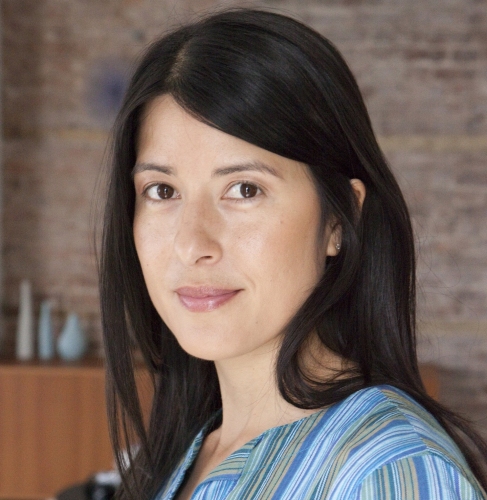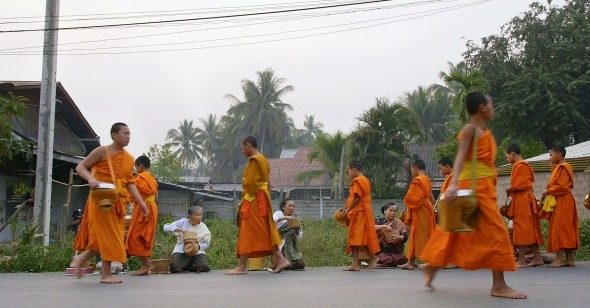Patient Perception:
An Interview with Kimi Takesue (Onlookers)
By Natalia Keogan
While vacationing in Laos, the Japanese American filmmaker Kimi Takesue decided to set up her camera in bustling areas, filming locals, tourists, monks, and animals as they enter and exit the static frame. Unsure of what would unfold within each extended take, Takesue created an enticing visual landscape by utilizing the picturesque backdrops that she encountered while traveling the country; the lingering effects of imperialism are felt within every tourist interaction: Westerners obnoxiously haggling Laotian vendors, passersby ogling saffron-robed Buddhist monks, strangers congregating to solitarily pose before the same iconic vista. The resulting film from this experiment, Onlookers, Takesue’s third feature, offers moments of spontaneous beauty, humor, and cheeky interaction with Takesue’s camera, showcasing the power of diverse human behavior, no matter how small the scope might seem.
Onlookers is part of the Metrograph series “Fire Over Water: Films of Transcendence,” spotlighting films from similarly meditative auteurs like Apichatpong Weerasethakul, Bi Gan, and Phạm Thiên Ân. Later this month, Takesue’s previous two features—her kinetic Ugandan travelogue Where Are You Taking Me? (2010) and a charming tribute to her grandfather’s golden years 95 and 6 to Go (2016)—will also be available to watch alongside Onlookers on the theater’s streaming platform. Takesue’s filmography is preoccupied with perception: of people, places, generations, and cultures. Her films argue that our ability to patiently observe is often all that stands in the way of personal enlightenment and cross-cultural connection.
I spoke with Takesue to discuss her filmmaking process, what it means to create slow cinema in an age of persistent distraction, and how her three features inform and delineate one another.
Reverse Shot: First, I want to ask about your multi-hyphenate role of director, cinematographer, editor, and producer on Onlookers. What were the challenges and rewards of this all-encompassing approach?
Kimi Takesue: I take such an exploratory approach to this kind of filmmaking, so there really isn't a plan. I'm not consciously thinking of all these different roles. In this case, I found myself interested in visiting Laos, bringing my camera and going into it without expectations or an agenda. The advantage is that I can be very quiet and intuitive in how I’m responding to what’s unfolding; I don’t have to analyze, mythologize or justify any of it. It lends itself to looseness, intimacy, and a sense of play. Obviously, I have ongoing interests, like cross-cultural encounters or different aspects of tourism. But I'm just responding as a person with an accumulation of these interests, and I am guided by that basic curiosity. The beauty of it is that it’s a form of meditation, and that's why I enjoy it as an act of filmmaking.
There is a certain kind of patience that is impossible to achieve when there are other people around, at least for me, because I am very responsive to the needs and anxieties of other people. It would be very hard to allow myself to slow down. I've directed, produced, shot, edited and sound edited the whole body of films that I've made in this creative nonfiction space.
I never really know what it is that I'm doing, so in that sense, they've all kind of taken shape in the same way and over a considerable amount of time. A lot of times, I even let material sit for a number of years before revisiting it, and then I’m able to approach it with a certain distance to find the connective threads. The only exception to that was Where Are You Taking Me?, which was a commission by [International Film Festival] Rotterdam. It was an interesting experience because it was actually a response to the frustrations that are depicted in 95 and 6 to Go, around a feature fiction screenplay that never gets made, creating an anchor point for me to connect with my grandfather. Where Are You Taking Me? was made in the wake of that sense of failure I felt about that film not being made, and then 95 and 6 to Go emerged after that.
RS: I know that Onlookers manifested as a project while you were on sabbatical. You’re a tenured professor at Rutgers Newark, and I’m curious about how teaching film and interacting with students has influenced your own filmmaking practice?
KT: It's an incredibly diverse student body of mostly first-generation college students. They're such a fascinating group in terms of their interests, backgrounds, emotional maturity, and sense of hard work. It's very rewarding for me, because I'm in contact with these young people that have this great energy. I also reflect on how hard it was when I was younger to have role models, either filmmakers or professors, who were women of color. I think this dynamic fosters a recurring theme in my work, because I want to be seen and my films are all about people who are, in a way, not seen. As a teacher, you are trying your best to see your students in their specificity—what it is that they offer that is singular and beautiful to them. Because the student body is a group of underdogs in so many respects, I want to extend whatever I can offer. What I admire the most in my students, at least in this particular student body, is their lack of competition and how much appreciation they have for one another’s talent. Because of that, you see them grow in really exceptional ways, because they are truly inspired and grateful for what it is that their peers offer.
RS: You’ve spoken about how Onlookers and your other films necessitate active and immersed viewing, which feels like an increasingly demanding request in what you’ve called “this moment of incredible distraction.” As a professor, do you notice your students becoming increasingly averse to slow cinema, or have you been pleasantly surprised? What about general audiences?
KT: I have noticed shifts in tone, particularly since COVID, because there is a heaviness and a certain sadness that lingers. Societally, there’s been a shift across the board in terms of distraction and people being consumed by their phones. Whether you’re on the subway or anywhere else, everyone is on their phone. When students come into a classroom, they’re on their phones. They don’t interact like they used to. It takes a while to generate that interactive energy. Onlookers is very much about that; being in a state of distraction and the ways in which travel has really changed, because it used to be that people would interact in these sorts of boring, liminal spaces. That is when you would strike up conversations with people. Now what happens in that moment of discomfort, awkwardness, or boredom is that people just go to their phones. It's really changed things.
I actually teach quite a bit of fiction filmmaking, but I try to expose students to a lot of different kinds of styles. I think that good slow cinema still has something that is incredibly engaging within it. There can also be slow cinema that I think is boring, it’s not all intrinsically great. But I’m always trying to introduce them to the best of different styles of work. Personally, with my own work, I’m always trying to push certain boundaries and challenge an audience. At the same time, I'm really interested in accessibility. My students can access my films, in the sense that all it requires is patience and curiosity. Initially, I was interested in work that was theoretical and demanded more explanation in order to really appreciate it. But I became very conscious of wanting to make work that was more inclusive. I think sometimes that's mistaken for being simple, but it’s not. I think it's extremely hard to actually give the impression of something that feels simple but is actually very complex.
RS: We already touched on this a bit, but I would love to discuss Onlookers in relation to your films Where Are You Taking Me? and 95 and 6 to Go. Your work has routinely explored tourism, cultural difference, and human connection, but what most interests me about these three titles is how you capture the landscapes of Laos, Uganda, and Hawaii. Can you briefly detail how you approached these places you’ve had varying degrees of familiarity with?
KT: There are a lot of recurring themes. There is this ongoing pulsation between voyeurism and intimacy. In all of these films, even those that relate to my family, there is this sense of difference and the ways that you can stereotype, exoticize, and underestimate people, or even see them with greater clarity. These tensions are always at play. In terms of perspective, I am impacted by landscapes. The way in which I use landscape is often as a place of meditation and reflection. It is almost like a moment of pause. Obviously they're integrated into scenes, but within the context of, say, 95 and 6 to Go, it's as if the home is an essential character in its own right. It offers so much in terms of what it reveals about my grandfather, and the viewer really explores every single nook and cranny. But then the film extends to the surrounding landscape of Hawaii, which also serves as a metaphor for this elderly man who exists on his own island, which is his home. The beauty of Hawaii has really defined who he is, but at this point in his life, he has almost no access to it. It was so important to show the environment that has shaped him, but also provide this bit of visual pleasure after you've been contained in his home. Rhythmically, it provides a moment to reflect on what you've just seen in these different moments with him.
Similar devices arise somewhat unconsciously for me in a number of my films. In Where Are You Taking Me?, something that's distinctive about it is that it’s recreating the rhythms of cross-cultural travel in a more experiential way. It's very much a film about moments of dynamism, discombobulation, and overstimulation, and then moments of pause and respite. The thing with filming in Uganda was that I had more connections to local people and artists. It has a very different feel. I really was invited to a private wedding. I was invited to this school for kids impacted by the civil war. Entry into one space led to the next. With Onlookers, I had freedom to move on my own time, but I was following a very standard tourist itinerary. While I was also going a little off that route in terms of parallel side streets and interacting with locals to some degree, I still found that people were, understandably, a little guarded in the presence of tourists. I didn't really have any “ins” in terms of local friends or connections. So, the vantage point is distanced and always within public spaces. They each offer something unique in terms of rhythm.
RS: While the vantage point is, as you say, a bit more distanced in Onlookers, I think it does beautifully distill this interest you have with what it means to gaze—for yourself as a filmmaker, the film’s subjects, and the eventual audience.
KT: Definitely. In Onlookers, the stylization is very particular because it’s composed of the static long takes and tableaus that almost mimic a postcard, which is the quintessential image that is being critiqued. There’s a certain way that those images can fetishize or exoticize a place or a culture. They’re being indulged in and critiqued sort of simultaneously, but in a way that’s very naturalistic and spontaneous.

